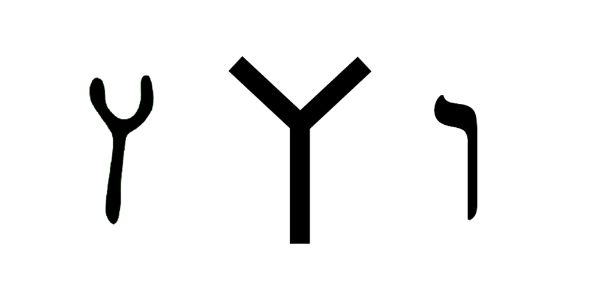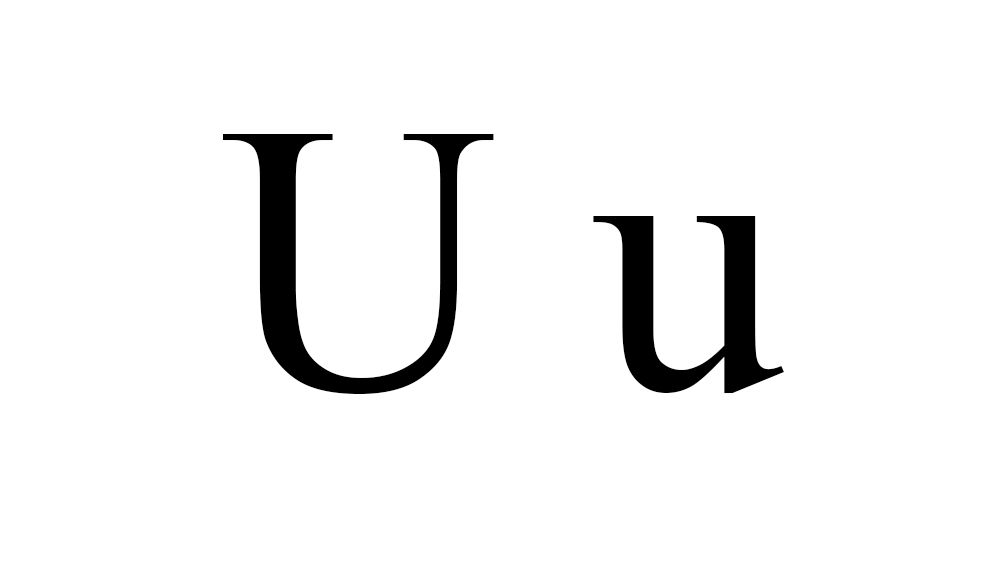Acceptable ways to write it: uau (uu), uatad (utd), ýaý (ýý), ýatad (ýtd)
The letter uau (𐤅) aka ýatad (𐤅) or U/u is the sixth letter in the Afroasiatic language known as Paleo-Hebrew (Ābarayat). The letter has been equated with the letter U, the letter V, the letter W, the letter F, and the letter Y in the English language. However, the actual letter for it is the Ý which is related to the ʊ and produces the same sound as the letter U. Even though the Ý is the most accurate written letter we choose to use the U in our dictionary as it holds the closest pronunciation to the original intent of the Ý in the English language. The letter Y evolved into the letter U which evolved into the letter V and then later into the letter W.
There are supporting records that the 𐤁𐤏𐤋𐤉 𐤄𐤌𐤎𐤅𐤓𐤄 (Baālay HaMasauarah) or The Masoretes replaced the yaād (𐤉) with their version of the ýatad (𐤅) as the uau (𐤅) in some words. Nonetheless, this has caused confusion on the proper spelling of the name of the Most High and has resulted in: YaHaUaH, YaHaVaH (YeHoVaH), and YaHaWaH (YaHWeH), and YaHaYaH/AHaYaH for our father and Creator’s name.
The Paleo-Hebrew language or the original language of the Ābarayam is one spoken with an emphasis on the rauakh (breath, wind, spirit). With the language of the Ābarayam, each letter has a meaning and a number associated with it that adds meaning to each word they’re used with. Below you will be able to learn more about the letter in Ancient Hebrew, Yiddish Hebrew, Greek, and much more.
Letter Meanings
| Letter | Meaning |
|---|---|
| 𐤅 (u) – ua [ýa] | and, nail, tent peg, hook, to secure, connect, Messiah |
| Prefix | and |
| Suffix | him, masculine form, it, you, they |
| Number | 6 |
Based on the meaning of the letters the word could be defined as:
Definitions for 𐤅 / u
| Language | Word | Transliteration | Pronunciation | Definition |
|---|---|---|---|---|
| Ābarayat | 𐤅 | u | oo | nail, tent peg, add, hook, to secure, connect, Messiah |
| English | U u | u | /ˈjuː/ | the twenty-first letter and the fifth vowel of the modern English alphabet. |
| Hebrew | ו | w | /w/ | hook, nail |
| Arabic | و | w | /wa/ | add up, Fastening, Passive, Attach |
| Greek | Ϝ ϝ / Υ υ / Ψ ψ | w / u / ? | [w] / [u] / [?] | Digamma: the sixth letter of the Greek alpha-beta |
Images for 𐤅 / u


History of Meaning
The pictograph of the word is a nail, tent peg, or a straight line with a hook on top. Also, the letter is used as the conjunction “and” connecting two things together such as man “and” woman. For the Ābarayam the tent was supported by ropes attached to pegs driven into the ground. The pegs were made of a branched piece of hardwood. When the letter is used as the first letter of a verb it can reverse the tense of the verb from past tense to future tense or future tense to past tense while still connecting thoughts.
History of the Letter Ý
The letter Ý in Kazakh was suggested as a letter for the voiced labio-velar approximant (as well as the diphthongs /ʊw/ and /ʉw/); the corresponding Cyrillic letter is У. The 2021 revision proposed the letter U, with the letter U with a macron (Ū) for the U sound in Kazakh.
U (У у) is a letter in the Cyrillic script. It commonly represents the close back rounded vowel /u/, somewhat like the pronunciation of ⟨oo⟩ in “boot” or rule. The forms of the Cyrillic letter U are similar to the lowercase of the Latin letter Y (Y y; Y y).
Historically, Cyrillic U evolved as a specifically East Slavic short form of the digraph ⟨оу⟩ used in ancient Slavic texts to represent /u/. The digraph was itself a direct loan from the Greek alphabet, where the combination ⟨ου⟩ (omicron-upsilon) was also used to represent /u/. Later, the o was removed, leaving the modern upsilon-only form.
Consequently, the form of the letter is derived from the Greek upsilon ⟨Υ υ⟩, which was parallelly also taken over into the Cyrillic alphabet in another form, as Izhitsa ⟨Ѵ⟩. It is normally romanized as “u”, but in Kazakh, it is romanized as “w”.
History of the Letter Ʊ
The letter Ʊ (minuscule: ʊ), called horseshoe or sometimes bucket or sometimes inverted omega, is a letter of the International Phonetic Alphabet used to transcribe a near-close near-back rounded vowel. Graphically, the lower case is a turned small-capital Greek letter omega (Ω) in many typefaces (e.g. Arial, Calibri, Candara, Liberation, Lucida, Noto, Times New Roman), and historically it derives from a small-capital Latin U (ᴜ), with the serifs exaggerated to make them more visible.
However, Geoffrey Pullum interpreted it as an IPA variant of the Greek letter upsilon (υ) and called it Latin upsilon, the name that would be adopted by Unicode, though in IPA an actual Greek upsilon is also used for the voiced labiodental approximant; Pullum called this letter script V and Unicode calls it V with a hook. Horseshoe is used in the African reference alphabet and national alphabets such as those of Anii and Tem. It most often has the value of /u/ with a retracted tongue root.
History of the Letter U
The letter U was introduced in 700 BCE (3225 AM). There’s a lot of confusion among letters “U,” “V” and “W.” The Phoenicians began using a letter that looked like our “Y” with a “U” top rather than a “V” top around 1000 BC. They called it “uau” meaning “peg.” The Greeks adopted this in 700 BC and called it “upsilon.”
In Greek, the name of the letter was originally just “υ”, but the name changed to “υ ψιλόν” u psilon ‘simple u’ to distinguish it from οι, which had come to have the same [y] pronunciation. In early Attic Greek (6th century BCE), it was pronounced [u] (a close back rounded vowel like the English “long o͞o”).
Our letter U was originally written as we now write “V”, which was a Latin version of the Greek letter Upsilon (written Y). The Latin form of this letter dropped the stem, and it became written “V”. The rounded form U began to gain in popularity in the late 1300’s, using the rounded shape within words, but using the V-shape at the beginning of words. The “V” shape originally had the sound of our modern letter U, but the labial sound of “V” is a rather new development.
History of the Letter V
The letter V was introduced in 1386 CE (5311 AM). The Romans (Latin) did not differentiate between “V” and “U” sounds. Even Shakespeare used “U’s” in place of “V’s” in his plays and poems. Capital “V’s” at the start of words started to appear in the 1400s. It was not required in Latin to represent the bilabial semivowel (w), for the Latins had taken the letter V to represent both this sound and the corresponding vowel (u).
During the Late Middle Ages, two minuscule glyphs developed which were both used for sounds including /u/ and modern /v/. The pointed form “v” was written at the beginning of a word, while a rounded form “u” was used in the middle or end, regardless of sound. So whereas “valour” and “excuse” appeared as in modern printing, “have” and “upon” were printed as “haue” and “vpon”.
History of the Letter W
The letter W was introduced in 1700 CE (5625 AM). During the Middle Ages, Charlemagne’s scribes placed two “U’s” side by side with a space between (as in literally “double U”), a new letter that sounded like a “V.” It wasn’t until around 1700 that W as a unique letter (not two “U’s” or two “V’s” placed side-by-side) emerged in printing presses across Europe. In French, this letter is still referred to as “double V.”
The letter double-U doesn’t have a great deal of history to it. There are some who have strained to imagine this letter to have begun during the 7th century CE, when it first appeared by writers of Old English as a pairing of the letter U, (uu). The word “witch” was originally spelled vvitch (vv). The use of the double-u certainly didn’t begin to become popularized until the 13th century in any other languages.
Definitions for 𐤅𐤉 / uay
When adding the 𐤉 (yad) to the end of a word, it creates a possessive of the original word. It can either signify “my…” or identify a member of a nation. For example, 𐤏𐤁𐤓 (Ābar) is the progenitor, but 𐤏𐤁𐤓𐤉 (Ābaray) is the singular descendant of him also known as a Hebrew.
| Language | Word | Transliteration | Pronunciation | Definition |
|---|---|---|---|---|
| Ābarayat | 𐤅𐤉 | uay | oo-ey | |
| English | ||||
| Hebrew | ||||
| Arabic | ||||
| Greek |
Images for 𐤅𐤉 / uay


Definitions for 𐤅𐤉𐤌 / uayam
When adding the 𐤌 (mayam) after the 𐤉 (yad) to the end of a word, it creates a plural of the original word. It can identify multiple members of a nation. For example, 𐤏𐤁𐤓 (Ābar) is the progenitor, but 𐤏𐤁𐤓𐤉𐤌 (Ābarayam) are the plural descendants of him also known as Hebrews.
| Language | Word | Transliteration | Pronunciation | Definition |
|---|---|---|---|---|
| Ābarayat | 𐤅𐤉𐤌 | uayam | oo-yawm | and sea |
| English | ||||
| Hebrew | ||||
| Arabic | ||||
| Greek |
Images for 𐤅𐤉𐤌 / uayam


Definitions for 𐤅𐤉𐤕 / uayat
When adding the 𐤕 (tau) after the 𐤉 (yad) to the end of a word, it creates a plural of the original word. It identifies the language or a sign of a nation’s existence. For example, 𐤏𐤁𐤓 (Ābar) is the progenitor, but 𐤏𐤁𐤓𐤉𐤕 (Ābarayat) is the language of him also known as Paleo-Hebrew language.
| Language | Word | Transliteration | Pronunciation | Definition |
|---|---|---|---|---|
| Ābarayat | 𐤅𐤉𐤕 | uayat | oo-yawt | |
| English | ||||
| Hebrew | ||||
| Arabic | ||||
| Greek |
Images for 𐤅𐤉𐤕 / uayat


Classification
You can continue your studies of the words by viewing Strong’s entries for:



